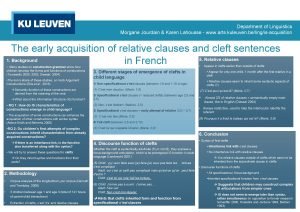Department of Linguistics Morgane Jourdain Karen Lahousse www

- Slides: 1

Department of Linguistics Morgane Jourdain & Karen Lahousse - www. arts. kuleuven. be/ling/is-acquisition The early acquisition of relative clauses and cleft sentences 5. Relative clauses 1. Background in French • Many studies on construction grammar show children develop the forms and functions of constructions (Tomasello 2000, 2003, Diessel, 2004) • The lion’s share of these studies: on Verb Argument Constructions (Ellis et al. , 2016) Semantic function of these constructions are derived from the meaning of the verb What about the Information Structure (IS) function? 3. Different stages of emergence of clefts in child language (7) C’est quoi qu’est là? (Marie, 2; 7) 2/ Specificational c’est clauses (= reduced clefts) (between age 2; 0 and 2; 5) • • The acquisition of some constructions can enhance the acquisition of other constructions with similar syntax (Abbot-Smith and Behrens 2006) (3) C’est moi fais (Marie, 2; 5) • RQ 2: Do children’s first attempts of complex constructions inherit characteristics from already acquired constructions? (4) C’est lui qui s’appelle Dizane! (Marie, 2; 9) Do they inherit syntax and functions from their parts? 2. Methodology • Corpus analysis of the longitudinal Lyon corpus (Demuth and Tremblay, 2008) • 3 children between age 1 and age 3 (total of 121 hours of parent-child interactions) Extraction of clefts, c’est ‘it’s’ and relative clauses • Relative clauses seem to inherit some syntactic aspects of clefts (7) (1) C’est mon doudou. (Marie, 1; 9) (2) Non, c’est Nathan! (Nathan, 2; 5) • We will try to answer these questions for clefts Appear in clefts earlier than outside of clefts • Appear for only one child, 1 month after the first relative in a cleft 1/ Non-specificational c’est clauses (between 1; 8 and 1; 10 of age) • RQ 1: How do IS characteristics of constructions emerge in child language? If there is an inheritance link, is the function also transferred along with the syntax? • • 3/ Specificational c’est clauses + early attempt of relative (2; 0 – 2; 7) f Almost 2/3 of relative clauses = semantically empty main clause, like in English (Diessel 2004) • Always restrictive, used to help the interlocutor identify the referent (8) Pourquoi il a froid le bateau qui est là? (Marie, 2; 9) 4/ Full cleft (between 2; 6 and 2; 10) 6. Conclusion 4. Discourse function of clefts Whether the cleft is syntactically adult-like (5) or not (6), they express a focus-background articulation, which is its prototypical IS function in adult language (Lambrecht 2001) (5) Child: yyy veux faire avec j(e) faire j(e) veux pas faire les tortues c'est compliqué. Adult: oui c'est un petit peu compliqué mais qu'est-ce qu'on peut faire d'autre ? Child: c'est toi qui m(e) fait les tortues. (6) Child: J’arrive pas à ouvrir. J’arrive pas… Adult: Fais voir Child: Non c’est moi réparer. Hints that clefts inherited form and function from specificational c’est clauses • Syntax of first clefts • Inheritance link with c’est clauses • No inheritance link with relative clauses It is relative clauses outside of clefts which seem to be inherited from the subordinate clause in clefts • Discourse functions of clefts • All specificational, focus-background • Inherited specificational function from c’est clauses Suggests that children may construct complex IS articulations from simpler ones IS does not seem to emerge later than syntax, rather simultaneous (in opposition to former research: Schaeffer 2000, Hoekstra and Jordens 1994, Barbier 1993)

